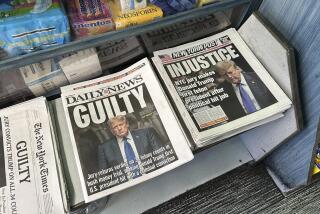Measuring the Media: Four Key Shifts in 1988
- Share via
ALEXANDRIA, VA. — Politics in 1988 took roughly one TV minute, and one newspaper inch, out of every eight put in front of the public. Editors gave the campaigns full treatment, but the media hedged its bets by expanding the nation’s total news volume, in effect merely adding on politics.
In the nation as a whole the flow of news was up 10% over 1987, according to figures from the National Media Index.
What do the year’s other big stories say? They show once again that many of our regular concerns--money, crime and society’s “fairness”--remain strong and steady worries. One of the most remarkable facts about media coverage is that many major themes, or issues, get the same levels of coverage year after year.
Other than the election, 1988 was a normal year; shifts were few. But they were important for the future.
Each of four changes sends a strong message, heavily reinforced by continual exposure. To give an idea of magnitude, 1% of national media coverage for one year equals 250,000 newspaper column inches in the top 50 markets, or 416 minutes of evening network news. This was the entire coverage of South Africa and all its troubles in 1988. All of the four changes had exposure at least four times as great as the South African situation.
The media messages of the year were:
1) U.S.-Soviet relations: The Cold War is ending and the world is passing through a generational change.
Throughout the ‘80s the Soviet Union has had far more coverage in the U.S. media than any other country, or of all Western Europe and Japan combined. The Cold War has fueled an enormous curiosity--and intense nuclear fear.
Mikhail S. Gorbachev has apparently brought quick relief. The Soviet leader had greater coverage than Ronald Reagan through most of 1988. But this did not hurt the President or his Administration. As Reagan might have put it, the public sees Gorbachev as buying our philosophy--we’re not buying his. As a result, coverage of the Soviet Union remained high, but much more neutral than in the past.
2) Corporate Leadership: The business of America is business; politics needs to be kept in perspective.
Of all the major themes the media played throughout the year, the fascination with the rule of private enterprise is probably the most significant. The message is that the media, and presumably also the public, bought Reagan’s view on the importance of American business.
In the last four years, coverage of corporate leadership has risen steadily. It reflects a growing public belief that many problems once left to government now belong to private enterprise. Of all the media trends apparent in this decade, this one is the most consistent. It encompasses concern about the loss of known firms to takeovers or, worse, foreign acquisition. This trend also says a lot about how people want to see the country work.
3) The Environment: The next big global struggle will be over protecting it.
The biggest jump in coverage for the year was registered by environmental issues. They were boosted in the latter part of the year by two big, running stories: the fires in Yellowstone and the plight of whales off Alaska. Both were stories individual Americans could relate to.
Deeper worry came earlier from more distant problems like the depletion of the ozone layer and the scare over the greenhouse effect. Worry over the environment was expressed in local actions to recycle waste, protect water supplies and fight food contamination. But these were egged on by growing awareness of the global dimensions of these problems.
Recognition of the worldwide scope of environmental problems leaves many people feeling hopeless. But they are also looking for ways to deal with the threat. Politicians began to see the need for more international cooperation. With the Cold War cooling, the environment bids to become a central focus on international relations, and tension, in the next decade.
4) Health: Personal well-being may have to be limited by cost.
A drop in health coverage came from declining attention to acquired immune deficiency syndrome. For the first time in the 1980s, health failed to be the No. 3 worry--after money and crime. Health topics are now seen less positively. Where reporting on medical breakthroughs used to balance out even the dreaded news over AIDS, the message has changed, putting limits on the once-strong optimism that society might eventually be able to deal with all the sick.
For the first time in the 1980s, the problem of health costs rose in prominence as compared with other health issues. For years the media have treated the cost problem as an almost secondary matter. They tended to confirm the idea that eventually whatever needed to be done about personal health could and would be done. No longer. The specter of health rationing and the setting of limits on how much the country can spend on keeping everyone fit are beginning to emerge.
The sum of these messages is that the capitalistic middle-class view of the world advanced in strength in 1988. Last year’s messages affirm the retention of the status quo, Republicans in the White House and Democratic majorities on Capitol Hill. This message marks a sharp shift from the highly political messages of 1987. Led by the Iran-Contra affair, those were almost uniformly critical of the Reagan Administration. The 1988 messages were, by contrast, almost nonpolitical and suggest a more business-like approach to national problems.
More to Read
Sign up for Essential California
The most important California stories and recommendations in your inbox every morning.
You may occasionally receive promotional content from the Los Angeles Times.













